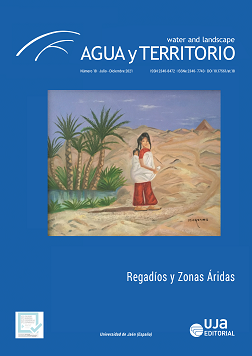La red molinar de la Sierra Morena occidental a finales del siglo XV
DOI:
https://doi.org/10.17561/at.18.5230Palabras clave:
Molinos hidráulicos, Red fluvial, Orografía, Toponimia, Sierra de Aracena, Siglo XVResumen
El presente trabajo tiene como cometido reconstruir la red molinar que se formó a finales del siglo XV en la actual comarca de la Sierra de Aracena, conocida entonces como Sierra de Aroche. Se trata de un conjunto excepcional de más de 250 ingenios, que sólo se explica por las características del medio natural donde se radicaron. Además, para tal reconstrucción, a través de 13 mapas, realizados gracias a una serie de informes redactados en la época sobre tales instalaciones, ha sido vital contar con multitud de datos toponímicos presentes en ellos. Las conclusiones y la información que aporta este análisis, abren muchas posibilidades de estudio en ámbitos relativos al crecimiento económico y demográfico, así como a las relaciones sociales en esta comarca.
Descargas
Referencias
Bueno Hernández, F. 2012: “Las obras hidráulicas medievales en España. Una visión general”, en Val Valdivieso, M.I. del y Bonachía Hernando, J.A. (coords.), Agua y sociedad en la Edad Media hispana, Granada, Universidad.
Córdoba de la Llave, R. 1990: La industria medieval del Córdoba, Córdoba, La Caja.
Córdoba de la Llave, R. 1993: “Molinos y batanes de la Córdoba medieval”. Ifigea, 9, 31-56.
Córdoba de la Llave, R. 2002: “Sobre el origen y difusión de los Molinos de Regolfo”. III Jornadas de Molinología, Murcia.
Luis Corral, F. 1996: “Feudalismo y molinos la posesión de aceñas en Zamora en el siglo XII”. Studia Zamorensia, 3, 53-75.
García Fiz, F. 1998: “Política internacional, conflictos jurisdiccionales y construcciones militares a finales del siglo XIII en la sierra de Aroche: los castillos de Cumbres y Santa Olalla”, Huelva en la Edad Media: reflexiones, aportaciones y nuevas perspectivas veinte años después, en Carriazo Rubio, J. L. y Miura Andrades, J. M. (eds.), Huelva en la Edad Media: reflexiones, aportaciones y nuevas perspectivas veinte años después, Huelva, Universidad de Huelva.
González Arce, J. D. 2020a: “Inmuebles de los pueblos de Sevilla dedicados a actividades económicas a finales del siglo XV”, Archivo Hispalense, CIII(312-314), (en prensa).
González Arce, J. D. 2020b: Un patrimonio concejil ingente: el almojarifazgo de los pueblos de Sevilla (ss. XIII-XV), Murcia, Sociedad Española de Estudios Medievales.
Maluquer de Motes Bernet, J. 1982: “De nuevo sobre el molino hidráulico”. Investigaciones Económicas, 18, 79‑86.
Moreno Lázaro, J. 2018: “Negocio, tecnología e instituciones en la molienda del trigo en Castilla la Vieja y León a mediados del siglo XVIII”. Investigaciones históricas: Época moderna y contemporánea, 38, 219-256, https://doi.org/10.24197/ihemc.38.2018.219-256
Oliver Narbona, M. 1983: Molinos harineros de agua, Alicante, Universidad.
Pérez Moreno, J. L. 2019: Los molinos de Alcalá de Guadaíra: Orígenes, expansión y ocaso (siglos XIII al XX), Alcalá de Guadaíra, Ayuntamiento.
Pérez-Embid Wamba, J. 1996: Aracena y su sierra. La formación de una comunidad andaluza (siglos XIII-XVIII), Huelva, Diputación.
Pérez-Embid Wamba, J. 1998: “Las Sierras de Aroche y Aracena: la formación de una unidad comarcal en el Reino de Sevilla durante la Baja Edad Media”, en Carriazo Rubio, J.L. y Miura Andrades, J.M. (eds.), Huelva en la Edad Media: reflexiones, aportaciones y nuevas perspectivas veinte años después, Huelva, Universidad de Huelva.
Sánchez Jiménez, F.J. 2015: Estudio histórico-técnico de los molinos hidráulicos de Alcalá de Guadaíra, Tesis Doctoral, Sevilla
Publicado
Número
Sección
Licencia
Derechos de autor 2021 José Damián González Arce

Esta obra está bajo una licencia internacional Creative Commons Atribución 4.0.
© Universidad de Jaén
Los originales publicados en las ediciones impresa y electrónica de esta Revista son propiedad de la Universidad de Jaén siendo necesario citar la procedencia en cualquier reproducción parcial o total.
Salvo indicación contraria, todos los contenidos de la edición electrónica se distribuyen bajo una licencia de uso y distribución “Creative Commons Reconocimiento 4.0 España” (CC-by). Puede consultar desde aquí la versión informativa y el texto legal de la licencia. Esta circunstancia ha de hacerse constar expresamente de esta forma cuando sea necesario.














